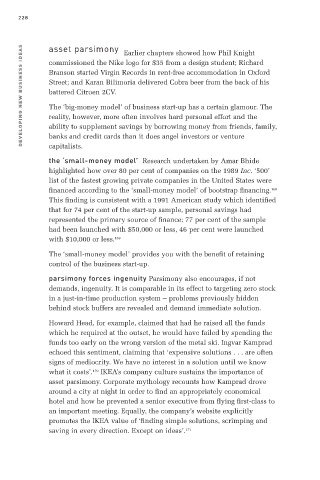Page 251 - DNBI_A01.QXD
P. 251
DEVELOPING NEW BUSINESS IDEAS228
asset parsimony Earlier chapters showed how Phil Knight
commissioned the Nike logo for $35 from a design student; Richard
Branson started Virgin Records in rent-free accommodation in Oxford
Street; and Karan Bilimoria delivered Cobra beer from the back of his
battered Citroen 2CV.
The ‘big-money model’ of business start-up has a certain glamour. The
reality, however, more often involves hard personal effort and the
ability to supplement savings by borrowing money from friends, family,
banks and credit cards than it does angel investors or venture
capitalists.
the ‘small-money model’ Research undertaken by Amar Bhide
highlighted how over 80 per cent of companies on the 1989 Inc. ‘500’
list of the fastest growing private companies in the United States were
financed according to the ‘small-money model’ of bootstrap financing.168
This finding is consistent with a 1991 American study which identified
that for 74 per cent of the start-up sample, personal savings had
represented the primary source of finance; 77 per cent of the sample
had been launched with $50,000 or less, 46 per cent were launched
with $10,000 or less.169
The ‘small-money model’ provides you with the benefit of retaining
control of the business start-up.
parsimony forces ingenuity Parsimony also encourages, if not
demands, ingenuity. It is comparable in its effect to targeting zero stock
in a just-in-time production system – problems previously hidden
behind stock buffers are revealed and demand immediate solution.
Howard Head, for example, claimed that had he raised all the funds
which he required at the outset, he would have failed by spending the
funds too early on the wrong version of the metal ski. Ingvar Kamprad
echoed this sentiment, claiming that ‘expensive solutions . . . are often
signs of mediocrity. We have no interest in a solution until we know
what it costs’.170 IKEA’s company culture sustains the importance of
asset parsimony. Corporate mythology recounts how Kamprad drove
around a city at night in order to find an appropriately economical
hotel and how he prevented a senior executive from flying first-class to
an important meeting. Equally, the company’s website explicitly
promotes the IKEA value of ‘finding simple solutions, scrimping and
saving in every direction. Except on ideas’.171

